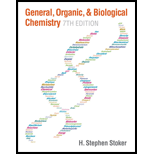
Concept explainers
(a)
Interpretation: To characterize Step 1 relative to the type of reaction that occurs in the glycolysis process.
Concept introduction: Glycolysis is the
The block diagram to represent an overview of glycolysis is as follows:

From the above diagram, it is concluded that in the overall process of glycolysis, two stages are present.
a) Steps 1 to 3 represents a six-carbon stage
b) Steps 4 to 10 represent a three-carbon stage
In the phosphorylation reaction, the molecule is attached to the phosphoryl group. The transfer of a phosphoryl group
In the isomerization reaction, a molecule transformed itself to another molecule, having the same number of atoms with a different arrangement.
(b)
Interpretation: To characterize step 3 relative to the type of reaction that occurs in the glycolysis process.
Concept introduction: Glycolysis is the metabolic pathway that breaks down a glucose molecule and converts it into two pyruvate molecules along with the production of two ATP molecules and NADH coenzymes.
The block diagram to represent an overview of glycolysis is as follows:

From the above diagram, it is concluded that in the overall process of glycolysis, two stages are present.
a) Steps 1 to 3 represents a six-carbon stage
b) Steps 4 to 10 represent a three-carbon stage
In the phosphorylation reaction, the molecule is attached to the phosphoryl group. The transfer of a phosphoryl group
In the isomerization reaction, a molecule transformed itself to another molecule, having the same number of atoms with a different arrangement.
(c)
Interpretation: To characterize step 5 relative to the type of reaction that occurs in the glycolysis process.
Concept introduction: Glycolysis is the metabolic pathway that breaks down a glucose molecule and converts it into two pyruvate molecules along with the production of two ATP molecules and NADH coenzymes.
The block diagram to represent an overview of glycolysis is as follows:

From the above diagram, it is concluded that in the overall process of glycolysis, two stages are present.
a) Steps 1 to 3 represents a six-carbon stage
b) Steps 4 to 10 represent a three-carbon stage
In the phosphorylation reaction, the molecule is attached to the phosphoryl group. The transfer of a phosphoryl group
In the isomerization reaction, a molecule transformed itself to another molecule, having the same number of atoms with a different arrangement.
(d)
Interpretation: To characterize step 5 relative to the type of reaction that occurs in the glycolysis process.
Concept introduction: Glycolysis is the metabolic pathway that breaks down a glucose molecule and converts it into two pyruvate molecules along with the production of two ATP molecules and NADH coenzymes. The conversion of a glucose molecule to the pyruvate molecules is an oxidation process in which no molecular
The block diagram to represent an overview of glycolysis is as follows:

From the above diagram, it is concluded that in the overall process of glycolysis, two stages are present.
a) Steps 1 to 3 represents a six-carbon stage
b) Steps 4 to 10 represent a three-carbon stage
In the phosphorylation reaction, the molecule is attached to the phosphoryl group. The transfer of a phosphoryl group
In the isomerization reaction, a molecule transformed itself to another molecule, having the same number of atoms with a different arrangement.
Want to see the full answer?
Check out a sample textbook solution
Chapter 24 Solutions
GENERAL,ORGANIC,+BIO.CHEM.-MINDTAP
- Using symbolic formulas such as ADP and PPi, write equations for the hydrolysis of ATP to ADP and the hydrolysis of ATP to AMP.arrow_forwardExplain why monitoring blood lactate levels might be a useful technique to gauge the amount of conditioning in an Olympic runner.arrow_forwardThe first step of the metabolic process known as glycolysis is the conversion of glucose to glucose- 6-phosphate. This process has a positive value for rG' Glucose + Pi Glucose-6-phosphate + H2O rG' = +13.8 kJ/mol-rxn This reaction is coupled to the hydrolysis of ATP ATP + H2O ADP + Pi rG' = -30.5 kJ/mol-rxn What is the sum of these two equations and the value of rG' for the coupled reaction? Is the coupled reaction product-favored at equilibrium?arrow_forward
 General, Organic, and Biological ChemistryChemistryISBN:9781285853918Author:H. Stephen StokerPublisher:Cengage Learning
General, Organic, and Biological ChemistryChemistryISBN:9781285853918Author:H. Stephen StokerPublisher:Cengage Learning Organic And Biological ChemistryChemistryISBN:9781305081079Author:STOKER, H. Stephen (howard Stephen)Publisher:Cengage Learning,
Organic And Biological ChemistryChemistryISBN:9781305081079Author:STOKER, H. Stephen (howard Stephen)Publisher:Cengage Learning, Chemistry for Today: General, Organic, and Bioche...ChemistryISBN:9781305960060Author:Spencer L. Seager, Michael R. Slabaugh, Maren S. HansenPublisher:Cengage Learning
Chemistry for Today: General, Organic, and Bioche...ChemistryISBN:9781305960060Author:Spencer L. Seager, Michael R. Slabaugh, Maren S. HansenPublisher:Cengage Learning Chemistry & Chemical ReactivityChemistryISBN:9781337399074Author:John C. Kotz, Paul M. Treichel, John Townsend, David TreichelPublisher:Cengage Learning
Chemistry & Chemical ReactivityChemistryISBN:9781337399074Author:John C. Kotz, Paul M. Treichel, John Townsend, David TreichelPublisher:Cengage Learning Chemistry & Chemical ReactivityChemistryISBN:9781133949640Author:John C. Kotz, Paul M. Treichel, John Townsend, David TreichelPublisher:Cengage Learning
Chemistry & Chemical ReactivityChemistryISBN:9781133949640Author:John C. Kotz, Paul M. Treichel, John Townsend, David TreichelPublisher:Cengage Learning Chemistry In FocusChemistryISBN:9781305084476Author:Tro, Nivaldo J., Neu, Don.Publisher:Cengage Learning
Chemistry In FocusChemistryISBN:9781305084476Author:Tro, Nivaldo J., Neu, Don.Publisher:Cengage Learning





